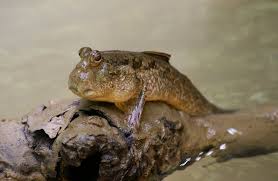In the brackish and muddy coastal habitats, a peculiar creature captures the imagination of observers with its incredible ability to thrive in both land and water. Meet the Mudskipper, a small but remarkable fish that has evolved unique adaptations to conquer two worlds. In this blog, we will delve into the fascinating world of the Mudskipper and explore the marvels of its adaptive prowess.
- Discovering the Mudskipper:
The Mudskipper, scientifically known as Periophthalmus, is a member of the Gobiidae family. These small, elongated fish are primarily found in the intertidal zones of tropical and subtropical regions across the globe. Their striking appearance and peculiar behavior have captured the attention of scientists and nature enthusiasts alike.
- Physical Characteristics:
Mudskippers have a distinctive appearance that sets them apart from other fish species. Their bodies are laterally compressed and elongated, allowing them to navigate the muddy terrain with ease. Their pectoral fins are well-developed and adapted to function like limbs, enabling them to “skip” and “walk” on land. These fins also aid in digging burrows in the mud, providing them with shelter during low tide.
- Breathing in Water and Air:
One of the most extraordinary traits of the Mudskipper is its ability to breathe both in water and air. While submerged, they rely on their gills to extract oxygen from the water. However, when they venture onto land during low tide, they supplement their breathing by using their moist skin and the well-vascularized linings of their mouths to absorb atmospheric oxygen.
- Feeding Behavior:
Mudskippers are opportunistic feeders with a varied diet. Their menu includes small crustaceans, insects, worms, and other tiny marine creatures. They use their protrusible mouths to snatch prey from both the water and land. Their ability to forage on land gives them a significant advantage in environments where food availability changes dramatically with tidal cycles.
- Navigating Land and Water:
Mudskippers have a unique and fascinating way of moving on land. They employ a skipping or hopping motion, where they push their bodies forward with their pectoral fins while dragging their tails. This distinctive locomotion allows them to explore the exposed mudflats for food and return to the safety of water when threatened.
- Social Structure:
Mudskippers are social creatures and often congregate in small groups. They establish territories that they fiercely defend, especially during the breeding season. Males engage in courtship rituals and displays to attract females and demonstrate their fitness as potential mates.
- Breeding and Parental Care:
During high tide, female Mudskippers lay their eggs in burrows they dig into the mud. After laying eggs, the females leave, and it is the male’s responsibility to guard the eggs and provide parental care. The males moisten the eggs with water and aerate them to ensure their survival until they hatch during the next high tide.
- Conservation Status:
While the Mudskipper is not currently considered threatened, it faces potential risks due to habitat destruction, pollution, and coastal development. The protection of their intertidal habitats is crucial for the long-term survival of these fascinating creatures.
Conclusion:
The Mudskipper’s remarkable ability to thrive in both land and water showcases the wonders of nature’s adaptation. With its unique physical characteristics, intriguing behaviors, and extraordinary lifestyle, the Mudskipper continues to captivate researchers and nature enthusiasts worldwide. By understanding and preserving these marvels of adaptation, we gain valuable insights into the diverse ways life has conquered Earth’s varied environments.




















Add Comment